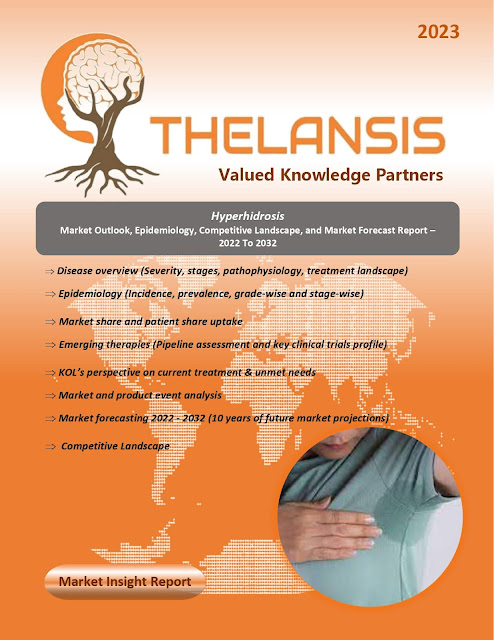Hyperhidrosis – Market Outlook, Epidemiology, Competitive Landscape, and Market Forecast Report – 2022 To 2032
Hyperhidrosis, a condition marked by
excessive sweating, arises from the overstimulation of cholinergic receptors on
eccrine glands. This disorder stands out by causing sweat production beyond
what is necessary for maintaining a stable body temperature. Eccrine glands are
most concentrated in axillae, palms, soles, and faces, making these regions the
primary sites linked with hyperhidrosis. The malfunctioning of the
acetylcholine negative feedback loop in these individuals is likely responsible
for the shift from a normal physiological response to an abnormal pathological
one. It is categorized into primary and secondary forms, each demanding
distinct approaches to management and treatment. The primary variant typically
emerges earlier in life and is characterized by more localized symptoms. On the
other hand, the secondary type usually arises due to medication side effects or
systemic conditions, particularly those involving the nervous system.
Classification of hyperhidrosis into primary or secondary is crucial because
the treatment strategies significantly differ between these two groups. Despite
various literature reviews, the exact cause of primary hyperhidrosis remains
unknown. Genetic factors are thought to contribute to excessive neural
stimulation, although the mechanism is not fully comprehended. Identifying
secondary causes is generally easier, as they are associated with medications
like dopamine agonists, selective serotonin reuptake inhibitors (SSRIs),
antipsychotics, and insulin, as well as systemic disorders including diabetes
mellitus, hyperthyroidism, Parkinson's disease, and other neurological
conditions, and even tumors like pheochromocytoma and lymphoma. It can be
prompted by almost any febrile illness, chronic alcohol misuse, and tuberculosis.
The development of segmental or localized hyperhidrosis is uncommon but can
occur in areas like the forehead, axilla, palms, feet, or forearms in certain
adults. Postmenopausal women might also experience moderate to severe
hyperhidrosis around their face and scalp. Eccrine sweat glands receive
sympathetic innervation through cholinergic fibers, which trigger impulses in
response to the body's temperature control needs during physical or
psychological stress. The hypothalamus's thermoregulatory center influences the
sweat glands through sympathetic innervation. The activation of muscarinic
receptors by cholinergic stimulation induces sweating. In cases of
hyperhidrosis, the sympathetic nervous system becomes hyperactive, leading to
excessive acetylcholine release from nerve endings. It is hypothesized that the
negative feedback mechanism to the hypothalamus might be compromised, causing
the body to sweat excessively for cooling. This pathological response can be
prompted by medications that enhance acetylcholine release or systemic medical
conditions that heighten sympathetic responses. Various topical and systemic
agents are available for treating hyperhidrosis. Initial treatment usually
involves using over-the-counter aluminum chloride hexahydrate at 20%
concentration for 3 to 4 nights and as needed on subsequent nights. A recent
addition to the treatment options is topical glycopyrronium tosylate, a
premoistened cloth containing a 2.4% glycopyrronium solution. Hyperhidrosis has
a guarded prognosis. While it's not life-threatening, it can lead to cosmetic
concerns and even work-related difficulties. People with severe hyperhidrosis
often experience a diminished quality of life.
·
The prevalence of hyperhidrosis is
approximately 4.8%, encompassing around 15.3 million individuals in the United
States. Among them, 70% report experiencing severe excessive sweating in at
least one body area.
Thelansis’s “Hyperhidrosis Market
Outlook, Epidemiology, Competitive Landscape, and Market Forecast Report – 2022
To 2032" covers disease overview, epidemiology, drug utilization,
prescription share analysis, competitive landscape, clinical practice,
regulatory landscape, patient share, market uptake, market forecast, and key
market insights under the potential Hyperhidrosis treatment modalities options
for eight major markets (USA, Germany, France, Italy, Spain, UK, Japan, and
China).
KOLs insights
of Hyperhidrosis across 8 MM market from the centre of Excellence/ Public/
Private hospitals participated in the study. Insights around current treatment
landscape, epidemiology, clinical characteristics, future treatment paradigm,
and Unmet needs.
Hyperhidrosis Market Forecast Patient
Based Forecast Model (MS. Excel Based Automated Dashboard), which Data Inputs
with sourcing, Market Event, and Product Event, Country specific Forecast
Model, Market uptake and patient share uptake, Attribute Analysis, Analog
Analysis, Disease burden, and pricing scenario, Summary, and Insights.
Thelansis Competitive Intelligence (CI) practice
has been established based on a deep understanding of the pharma/biotech
business environment to provide an optimized support system to all levels of
the decision-making process. It enables business leaders in forward-thinking
and proactive decision-making. Thelansis supports scientific and commercial
teams in seamless CI support by creating an AI/ ML-based technology-driven
platform that manages the data flow from primary and secondary sources.




Comments
Post a Comment